Running Head: COPD Foundation’s 20th Anniversary
Funding Support: Not applicable
Date of Acceptance: May 6, 2024 │ Published online date: Not applicable
Abbreviations: BRFSS=Behavioral Risk Factor Surveillance System; BRIDGE=Bridging the Gap Between Patients/Caregivers and COPD Research program; BRR=Bronchiectasis Research Registry; CAT=COPD Assessment Test; CBQC=COPD Biomarkers Qualification Consortium; CDC=Centers for Disease Control and Prevention; CIRCLES=Clinicians Improving Rural COPD Landscapes through Education in Self-care goals; CME=continuing medical education; CMS=Centers for Medicare and Medicaid Services; CNC=COPD Foundation Nebulizer Consortium;COPD=chronic obstructive pulmonary disease; COPDF=COPD Foundation; COPDGene®=COPD Genetic Epidemiology study; CSR=corporate social responsibility; FDA=U.S. Food and Drug Administration; JCOPDF=Chronic Obstructive Pulmonary Diseases: Journal of the COPD Foundation; LAMA=long-acting muscarinic antagonist; MORE=Maximizing Outreach in Rural Environments; NHLBI=National Heart, Lung, and Blood Institute; NIH=National Institutes of Health; NTM=nontuberculous mycobacterial lung disease; PCG=Pocket Consultant Guide; PCORI=Patient-Centered Outcomes Research Institute; PIVOT=Patient-Inspired Validation of Outcome Tools; PPRN=Patient-Powered Research Network; PRAXIS=Prevention and Reduction of Admissions via eXpertise and Innovation Sharing program; SGRQ=St George’s Respiratory Questionnaire; SPIROMICS=SubPopulation and InteRmediate Outcome Measures in COPD Study
Citation: Malanga E, Thomashow B, Wright J, et al. The COPD Foundation on its twentieth anniversary. Chronic Obstr Pulm Dis. 2024; 11(3): 247-260. doi: http://doi.org/10.15326/jcopdf.2024.0527
The COPD Foundation’s Origin
The COPD Foundation (COPDF) is a 501(c)(3) not-for-profit organization launched in 2004 under the leadership of John W. Walsh, a patient advocate (Figure 1). Several key factors, including the launch of a global effort to address COPD,1 the high burden of disease, 2 the lack of effective therapies,3 the low level of federal research funding (Figure 2),4 and the absence of a patient voice in COPD efforts, came together to bring about the COPDF.
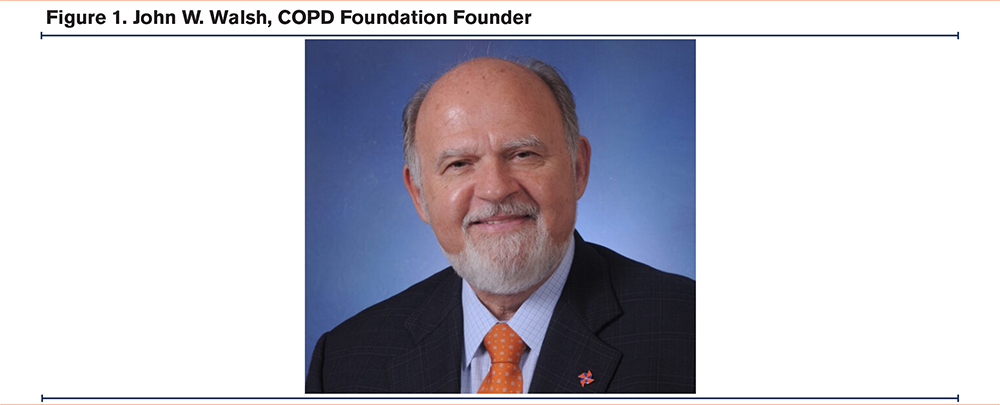
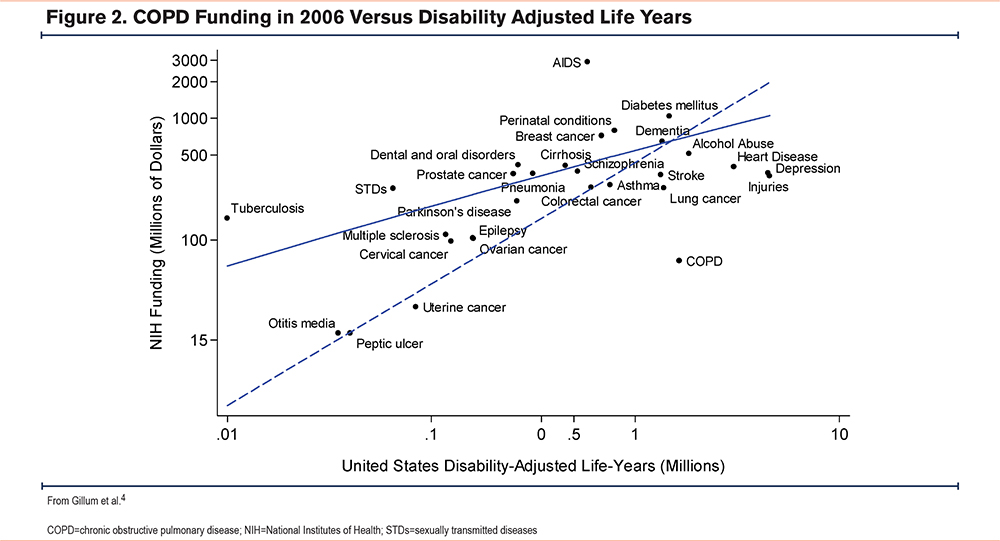
The mission of the Foundation is to help millions of people live longer and healthier lives by advancing research, advocacy, and awareness to stop chronic obstructive pulmonary disease (COPD), bronchiectasis, and nontuberculous mycobacterial (NTM) lung disease.5 Over the last 20 years, the COPDF has concentrated not only on the need for enhanced research, including the development of a COPD-specific medical journal,6 but also on increasing awareness and advocacy, providing education for patients, family members, health care providers, and providing a vehicle for the patient voice (Figure 3). In addition, the COPDF has been a leader in bronchiectasis and NTM lung disease, which is found in up to 30% of COPD patients,7,8 and developed the first patient research registry for patients with bronchiectasis and NTM lung disease.9 This manuscript will highlight the status of COPDF initiatives with a look toward what we expect in the next 20 years.
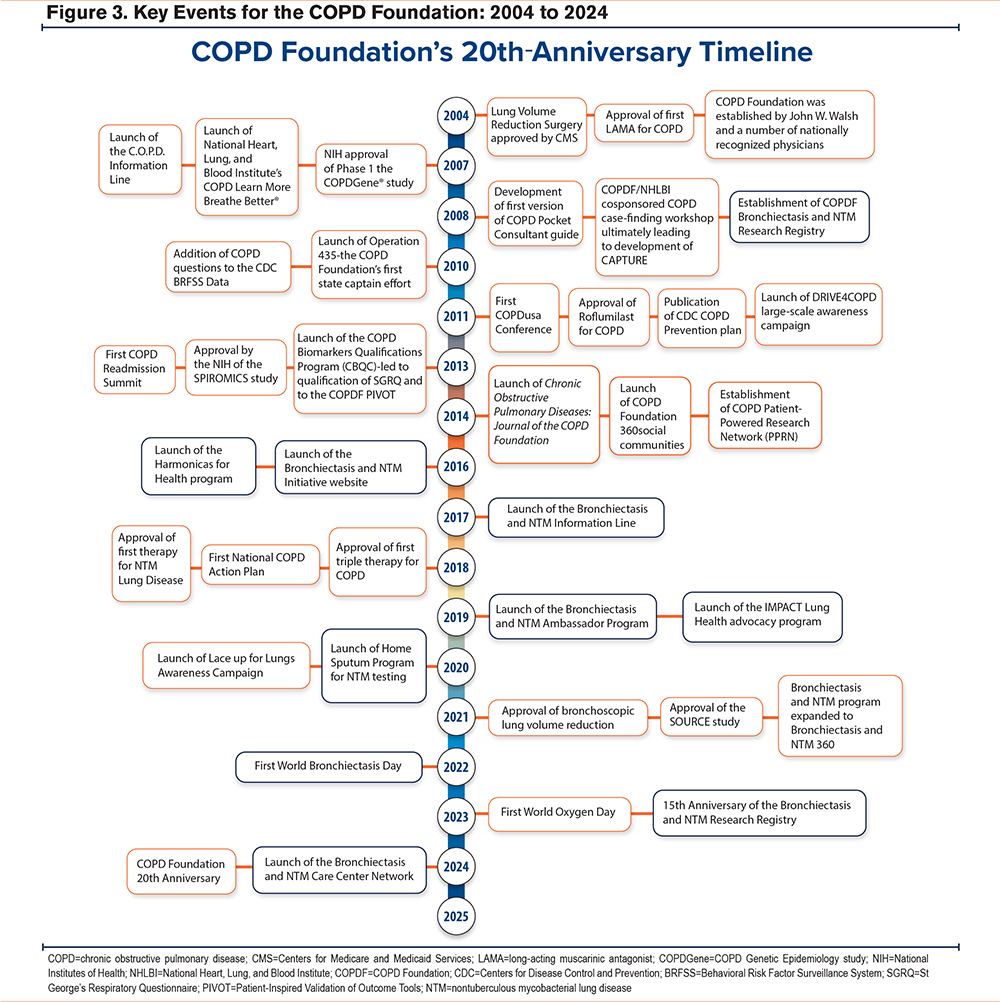
The COPD Foundation’s Accomplishments to Date
It its 20 years of existence the COPDF has been active in multiple efforts to improve the lives of COPD patients that will be expanded below. Many activities cut across more than one of these categories.
These include research, awareness and advocacy, patient/caregiver education and support, and provider education.
Research
Research has been central to the mission of the COPDF. The COPDF conducts its own research and collaborates on external research aimed at helping improve disease understanding, patient management, and the clinical research needed to identify and develop new interventions. The COPDF research framework aligns the goals of all key stakeholders including patients, caregivers, health care professionals, academics, government, other patient advocacy groups, and industry partners. An important aspect of COPDF research is to ensure a central role for the patient and caregiver at all key points of research projects including project conception and feasibility, study design, study conduct, data analysis and interpretation, and dissemination of results.
Research Support and Collaborations:
The COPDF works with sponsors of clinical trials as consultants on study design, study implementation, and conduct, including helping to support participant recruitment. In addition, the Foundation has helped support the major observational trials COPD Genetic Epidemiology (COPDGene®)10 and SubPopulations and InteRmediate Outcome Measures in COPD Study (SPIROMICS),11 which together have resulted in more than 600 publications that expand our knowledge of COPD. This includes a landmark publication that has fundamentally changed how COPD is defined and progresses, with the belief this will lead to earlier interventions and more effective therapies.12
Facilitating Development of New Treatments:
In 2010, the COPDF, in collaboration with stakeholders from industry, academics, and government agencies, established the COPD Foundation Biomarker Qualification Consortium (CBQC).13 The vision of the CBQC was to support the qualification, through the drug development tools qualification process of the U.S. Food and Drug Administration (FDA) and European Medicines Agency, of novel endpoints that could be used in proof of concept and registration studies of COPD therapies. The CBQC had several important successes, including the qualification of the first prognostic biomarker for COPD, plasma fibrinogen,14 the allowance by the FDA to cite the St George’s Respiratory Questionnaire (SGRQ) in drug labels,15 and the establishment of a Drug Master File for the COPD Assessment Test (CAT) questionnaire that allows sponsors to reference the validation dataset when submitting clinical trial results using the CAT to the FDA.16
In 2022, to address the changing needs of the FDA, the CBQC evolved into the Patient-Inspired Validation of Outcome Tools (PIVOT) program. This is a patient-centric framework for the coordination of activities to develop and validate biomarkers and clinical outcome assessments used to evaluate treatment benefit for pharmacological and nonpharmacological approaches in COPD, bronchiectasis, and other chronic lung diseases.17 PIVOT has already achieved success through the establishment of a Drug Master File for the Evaluating Respiratory Symptoms questionnaire.
Patient Registries and Patients as Research Partners:
The COPDF also promotes research through patient registries: the COPD Patient-Powered Research Network (PPRN)18 which is part of the COPD360 Framework (discussed below) and the Bronchiectasis and NTM Research Registry (BRR), which is led by the Bronchiectasis Research Consortium.9 The Consortium currently consists of physicians and researchers from 24 academic and medical centers from across the United States, and the BRR contains detailed baseline and follow-up information on patients with bronchiectasis and NTM, with over 6200 patients currently enrolled. The BRR has resulted in several publications that address important gaps in these diseases, and has facilitated recruitment into major clinical trials.19-21 The PPRN currently has over 6000 enrollees and has been used to support clinical trials and COPDF survey-based research.22
Ensuring that the patient voice is incorporated into all COPDF research includes soliciting patient input into projects via our Community Engagement Committee, a group of patients and caregivers.23 In 2019 the COPDF received funding from the Patient-Centered Outcome Research Institute (PCORI) for the Bridging the Gap Between Patients/Caregivers and COPD Research (BRIDGE) project to solicit input from patients and caregivers in identifying and prioritizing areas for current and future research. Results demonstrated 6 priority areas: reverse/cure COPD; develop better drugs for managing symptoms such as shortness of breath, cough, and sputum; improve medical equipment access and reimbursement; improve mobility; and reduce anxiety, fear, and depression.18
An outcome of the BRIDGE project was a COPDF-developed training program for patients: the BRIDGE Patient-to-Investigator Training.24 This modular based training aims to enable patients to better understand the research process and how research teams work, and to participate as members of research teams.
Chronic Obstructive Pulmonary Diseases: Journal of the COPD Foundation:
Chronic Obstructive Pulmonary Diseases: Journal of the COPD Foundation (JCOPDF) was launched in May 2014 as the first nonprofit, open-access journal focused on COPD.6 Under the leadership of founding Editor-in-Chief James D. Crapo, MD, (2014−2020), and current Editor-in-Chief Mark T. Dransfield, MD, (2020−present), this peer-reviewed medical/scientific journal includes an editorial board comprised of the world’s leading COPD experts. In 10 years, the JCOPDF has interacted with over 2500 COPD researchers and accepted manuscripts from 31 countries. Its articles are accessed over 23,000 times each month and in January 2024 it expanded from publishing 4 issues to 6, annually.
Awareness and Advocacy
Increasing awareness of COPD, bronchiectasis, and NTM lung disease and advocating for patients and lung health research funding has been another core mission of the COPDF. In 2004, public awareness of COPD was minimal, patients were considered mere spectators in their care, and federal research investment was reflective of the lack of knowledge and commitment from federal lawmakers. In addition, patients could not easily bring oxygen on planes, Medicare coverage for pulmonary rehabilitation was sporadic, there was no federal action to improve the prevention and management of COPD outside of tobacco cessation efforts, and only limited action existed to improve the quality of care delivered to COPD patients. The last 20 years have seen improvements, although a great deal of progress remains to be made.
Increasing Awareness:
The addition of a question about COPD in 2011 to the Behavioral Risk Factor Surveillance System (BRFSS), the world’s largest, ongoing, telephone health survey, was critical to advocacy efforts and reach. This resulted in improved information about the COPD population in each state and is readily available alongside other chronic disease indicators on the Centers for Disease and Prevention (CDC) website.25 Individual state “report cards” highlight important metrics such as COPD prevalence, COPD hospitalizations, male-female differences, and other measures.26 A second BRFSS module was deployed in 4 states in 2015 to identify people with respiratory symptoms but no COPD diagnosis, suggesting undiagnosed COPD.27
Finding the Missing Millions:
The COPDF Medical and Scientific Advisory Committee published a position statement to draw attention to the need to better identify people with undiagnosed COPD.28 However, the challenge to address those with undiagnosed COPD remains. To help with this clinical challenge, the National Heart, Lung, and Blood Institute (NHLBI) has funded studies to develop and validate a screening tool to detect people with undiagnosed COPD, (the COPD Assessment in Primary Care to Identify Undiagnosed Respiratory Disease and Exacerbation Risk [CAPTURE] tool) which includes a short patient questionnaire and measurement of their peak expiratory flow.29-31 Additional studies need to be performed to define and detect “early COPD” when disease may be more modifiable.32
The COPD National Action Plan:
The COPDF began laying the groundwork for the creation of a national strategy to address COPD in early 2010 supported by the establishment of the Foundation’s State Captain Program and engagement from the leadership of the Congressional COPD Caucus. Following the CDC’s development, in partnership with the COPDF, the document “Public Health Strategic Framework for COPD Prevention,”33 Congressional Caucus leaders called on the directors of the CDC and the National Institutes of Health (NIH) directly to develop a national strategy and to report to Congress on the progress. This led to a national meeting that included the COPDF and other partners in 2016 and the release of the first-ever COPD National Action Plan34 in 2018.
The plan laid out an ambitious roadmap for our country’s response to COPD, including goals and suggested actions for federal and state agencies, research and health professional communities, patient and public health organizations, and more. This plan signaled that COPD was a public health issue beyond tobacco cessation and showcased the many ways that outcomes could indeed be improved.
In the years following the release of the COPD National Action Plan, progress has been slow but steady. The plan’s power to transform outcomes is limited by the lack of funds to implement its recommendations, yet it has helped align efforts of public and private stakeholders, generated a focus on resources to address rural COPD inequities (discussed below) and helped support a modest increase in COPD research funding. The NHLBI continues to track progress of the plan.35
Addressing Health Inequities:
In the last decade the COPDF has expanded its reach into marginalized communities and prioritized health equity. This is particularly a problem in rural communities, which was the focus of a second NIH-sponsored meeting on the COPD National Action Plan.36 In 2020, to address the unique access issues faced by rural communities, the COPD Foundation launched the Clinicians Improving the Rural COPD Landscape through Education in Self-Care Goals (CIRCLES) program,37 focused on primary care offices in rural parts of the United States. This led to an expansion in 2021 and later grew into the Maximizing Outreach in Rural Environments (MORE) program. The MORE program included 2000 people with COPD in 26 states. Program sites included pulmonary rehabilitation centers, rural health clinics, critical access hospitals, a Veterans Administration medical center, and a Creek Nation public health department.
In addition, the COPD community has shared concerns about access to care and the cost burden of medications. Recognizing the cost burden of medications, limitations in access to care, and the unique needs that individuals with COPD in marginalized communities face, the COPDF initiated the Access Consortium in 2024. Via this consortium, and through collaborations with companies dedicated to reducing the medication cost burden, the COPDF is taking a proactive approach to identify, evaluate, and execute focused advocacy around access to COPD treatments, advocating and educating patients and caregivers, and ensuring affordability.
Support:
Contributions from individual donors and foundations and collaborations with corporate and industry partners have been integral to the success and growth of the COPDF. In 2022, the COPDF expanded its corporate collaborations to include a Corporate Social Responsibility (CSR) program. CSR is a strategy undertaken by companies to take an active and positive role in the world around them. It is generally categorized in 4 ways: environmental responsibility, ethical/ human rights responsibility, philanthropic responsibility, and economic responsibility. The COPD Foundation’s CSR program is designed to facilitate alignments with corporations interested in the lung health of their employees and community. As part of its commitment to corporate social responsibility, the COPDF affirms its dedication to building diverse and inclusive teams and to providing a creative and desirable work environment which increases productivity, innovation, and collaboration. The internal philosophy of the COPDF enables Foundation staff and volunteers to utilize the critical support provided by funders to better serve the community.
COPDF Response to COVID-19 Pandemic:
The COPD community experienced unique issues during the COVID-19 pandemic including difficulty with mask wearing, repercussions of isolation, an inability to access supplemental oxygen, and concerns about the safety of nebulized treatments and sputum collection. To address the social needs of the community, the COPDF began a series of virtual support group meetings which were met with such positive feedback that the COPDF continues to host these virtual social gatherings every month.
Access to Oxygen:
The COVID-19 pandemic worsened an already confusing situation related to oxygen access. While the past 20 years have seen advances that have allowed portable oxygen concentrators to become a practical solution for people needing oxygen supplementation, changes to oxygen equipment reimbursement schemes have decimated home medical equipment suppliers in the United States and access to modalities such as liquid oxygen has been nearly eliminated. In 2021, the COPDF launched the Oxygen360 initiative to address these critical issues (see below).
Advocacy Campaigns at the Federal Level:
As the COPDF refined its policy agenda to focus on actions that would support the creation and implementation of the COPD National Action Plan, IMPACT COPD was established as an annual day of action in Washington, DC. Since 2019, IMPACT COPD has involved over 300 COPD advocates and resulted in over 500 meetings with members of Congress on issues such as:
- Calling for more investment in COPD research at the NHLBI
- Funding COPD public health prevention and management programs at the CDC
- Reforming how oxygen is reimbursed in Medicare
- Making virtual pulmonary rehabilitation a permanent benefit
Patient and Caregiver Education and Support
Another critical component of the COPDF is providing support to COPD patients and their caregivers. This is done in several ways, including online support communities, educational materials, phone-based apps to educate patients, videos that educate patients on proper inhaler techniques, and more. This education and support also extend to the bronchiectasis and NTM community, and 2024 brings the launch of the Bronchiectasis and NTM Care Center Network, which will provide a greatly needed resource to this community of patients.
Online Communities:
In 2014, the COPDF identified a need to facilitate access to education and information for the COPD community. The COPD360 concept was initiated and designed to provide those affected by COPD access to “everything COPD” in one place. This included education and information on diagnosis, treatment, and quality of life issues.
The social communities, COPD360social and BronchandNTM360social, are integral parts of the COPDF websites. Having the online communities integrated into their respective websites facilitates ease for the user and enables them to access educational content via the social communities. Community members may post questions, provide answers, give status updates, share photos, provide and receive support and advice, and make new friends, all in real time. This also provides the COPDF a mechanism to receive feedback to ensure the needs of those affected by COPD and bronchiectasis and NTM lung disease are being met. As of mid-2024, COPD360social has nearly 60,000 members and the BronchAndNTM360social includes nearly 4000 members.
Patient and Caregiver Education:
The COPDF educational materials, both printed and digitally available, allow individuals to improve their disease self-management, refine their medication technique and adherence, comply with health care team recommendations, and improve their quality of life. The COPDF ensures that educational materials are easy to understand, current, and accurate. The educational materials also provide awareness and education on alpha-1 antitrypsin deficiency, the genetic form of COPD, and encourage testing for those at risk. The Foundation’s educational materials portfolio is detailed in Table 1.

Digital Engagement:
The COPDF offers several resources for the community to engage in learning and support through electronic means. Each month, the COPDF education team offers 3 live support groups to address unique needs related to COPD, bronchiectasis and NTM lung disease, and supplemental oxygen. The COPDF also uses podcasts, webinars, and Facebook “live” events which can be found on the COPD Foundation YouTube channel and websites.38 In 2023, the education team expanded its digital reach via a series of e-courses to spotlight a variety of topics ranging from alpha-1 antitrypsin deficiency to the impact that shingles (herpes zoster) can have on someone with COPD. In addition, the COPD Pocket Consultant Guide (see below) has a patient portal.
COPD Foundation Nebulizer Consortium:
During the COVID-19 pandemic there was confusion and uncertainty about the potential for nebulizer treatments to increase the transmission of SARS-CoV-2 and/or other infectious agents. The COPD Foundation Nebulizer Consortium (CNC)39 was established with the aim to improve the understanding of any potential infection risks that may be associated with the administration of nebulized therapies. The consortium conducted an extensive literature review of available information and concluded that existing evidence was insufficient to define the risk for exposure to infectious agents, calling for further research and issuing a guidance statement 40 with suggestions to mitigate potential risks when using nebulized treatments in the home or in health care settings. The CNC continues to focus on improving the understanding of any infection risks associated with nebulizer use. Ongoing activities include an understanding of real-world nebulizer use practices through a survey and broad dissemination of the guidance statement.
Home Sputum Pilot:
To minimize clinic visits for individuals with NTM lung disease during the COVID-19 pandemic, the COPDF, in collaboration with leading experts, conducted a home sputum pilot designed to enable physicians to prescribe a home sputum collection kit. This not only allowed individuals to remain home for sputum testing, but also provided unique access to a specialty testing center.
Oxygen360:
In 2021, the COPDF launched the Oxygen360 initiative to address issues related to oxygen access. The COPDF now offers a monthly virtual support and educational hour dedicated to oxygen therapy. The interdisciplinary Oxygen360 team updated and expanded the original guide to oxygen therapy into Oxygen Therapy Basics,41 a comprehensive reference.
After identifying an influx of imported devices sold over the counter through online retailers as oxygen concentrators despite having no formal evaluation by the FDA or any other regulatory body, the team partnered with leading experts to study these devices in more detail. This research found these “noncentrators” were inferior to prescription devices.42
Peer Support:
Building on the success of the “Call Our Patients Direct”-- C.O.P.D Information Line, in 2017, the Bronchiectasis and NTM Information Line was established to serve as a resource for those seeking information and guidance about the diseases. The Bronchiectasis and NTM Ambassador Program was launched in 2019 to educate and empower the patient community. Ambassadors are volunteers living with bronchiectasis and/or NTM lung disease who are supporting the patient community through advocacy, education, and engagement efforts.
Bronchiectasis and NTM Care Center Network:
The journey to diagnosis for patients with bronchiectasis and NTM lung disease can be quite lengthy, and patients may receive care from providers who do not fully understand how to manage and treat these complex diseases. In 2024 the Bronchiectasis and NTM Care Center Network was launched, aiming to reduce the time to diagnosis and support high quality care for this patient population. The vision for this program is that every patient receives a prompt, accurate diagnosis; the highest quality, patient-centered care; and the resources, education and support necessary to properly manage their disease. This innovative network will expand to 150 medical centers in diverse geographical locations nationwide over the next 3 years (Figure 4).
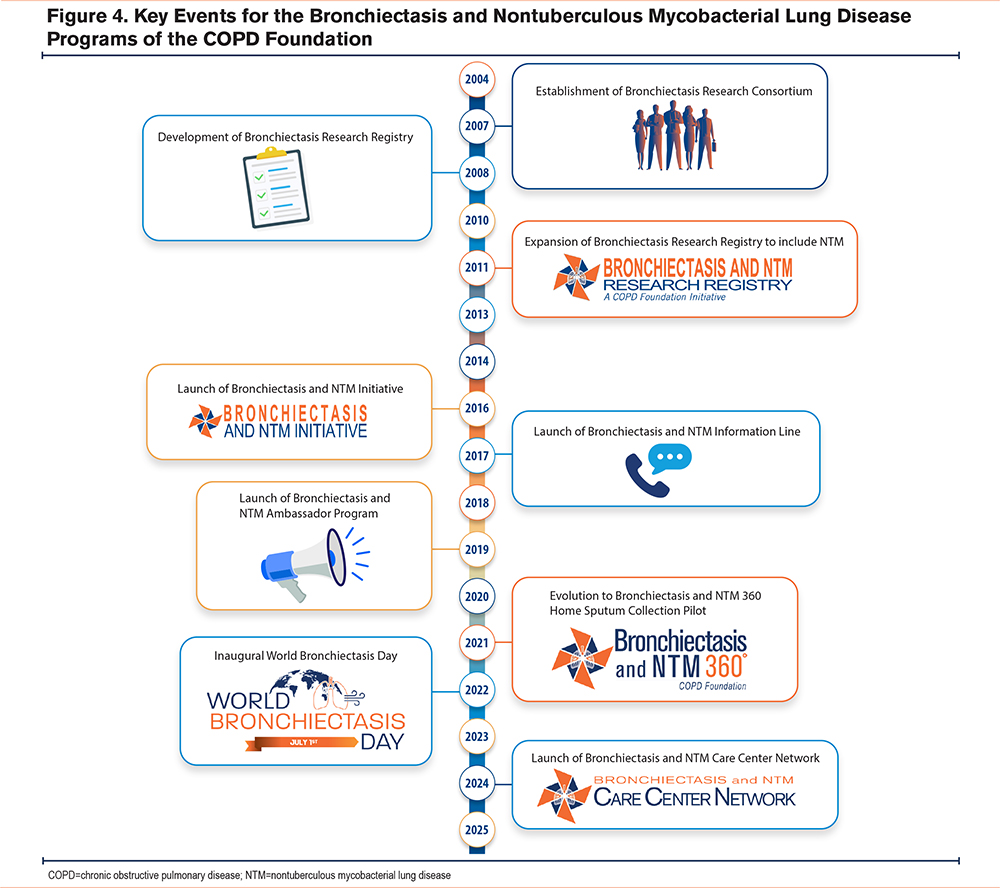
Provider Education
Education of health care providers is the final cornerstone of COPDF initiatives. These range from smart phone apps to educational materials to continuing medical education (CME) activities, available to health care providers and clinicians both in the United States and worldwide.
The 101 Library:
The 101 Library is a series of slide decks that cover COPD care and management, including general COPD information, genetic COPD, nebulization, bronchoscopic lung volume reduction, cultural humility, and new paradigms in COPD care.43 These slides are designed to empower health care providers in their ongoing care for individuals with COPD and provide them with tools they need to give educational presentations to their staff, professional organizations, or patient groups.
Continuing Medical Education Initiatives:
The COPDF continues to focus on CME and efforts include activities focused on COPD management, medication choices, and delivery device options. The focus includes choosing the correct medication and medication delivery device for each patient, taking into consideration factors such as cognitive issues and physical limitations.
The COPD PRAXIS Program and the Readmissions Institutes:
The Prevention and Reduction of COPD Admissions via eXpertise and Innovation Sharing (PRAXIS) program,44 was launched in 2015. This effort is aimed at fostering collaboration among health care professionals, health systems administrators, and policymakers, serving as a centralized platform for disseminating essential information necessary for the development of effective patient care protocols.
In tandem with PRAXIS, the Foundation organized 4 Readmissions Institutes between 2017 and 2022 in different regions of the country. These events, spanning one and a half days each, featured a blend of informative seminars focusing on topics pertinent to the COPD community, alongside interactive workshops designed to facilitate goal-setting exercises.
Attended by multidisciplinary teams comprising professionals from local hospitals, physician offices, and post-acute care providers, these Institutes served as forums for collaborative action planning. Participants engaged in formulating strategies aimed at improving outcomes for COPD patients and reducing readmission rates. Subsequent follow-up meetings revealed tangible improvements reported by participants, underscoring the effectiveness of the Institutes in fostering positive change within the COPD care landscape.
Educational Videos for Health Care Providers:
The COPD Foundation is committed to providing health care professionals with on-demand, easy to consume information that is relevant to the care of their patients. The Foundation’s YouTube Channel38 hosts a playlist dedicated to helping health care professionals improve the care they provide to patients with COPD. The videos in the playlist are aimed at reducing the burden of COPD exacerbations and hospital readmissions on patients, families, and professionals. The COPD for Health Care Professionals45 playlist is an extension of the PRAXIS Resource Repository and is a resource for health care professionals who treat people living with COPD.
The Pocket Consultant Guide:
In 2008, the COPDF introduced the COPD Pocket Consultant Guide (PCG), a compact resource tailored for busy medical settings. With numerous updates over the years, this guide has reached over 800,000 health care providers nationwide. Digital versions of the PCG have been downloaded over 14,000 times. Health care professionals may download the COPD Pocket Consultant Guide or order laminated copies via the COPD Foundation online catalogue.
In 2017, the COPDF launched a free PCG app for both iOS and Android users. Health care professionals can access updated definitions, treatable trait listings, spirometry screens, therapy flow charts, and more46 (Figure 5). Patients can utilize features like daily logging, goal setting, medication management, educational videos, and peer support through COPD360social.47 The PCG smart phone app has over 10,000 users in over 175 regions and countries.
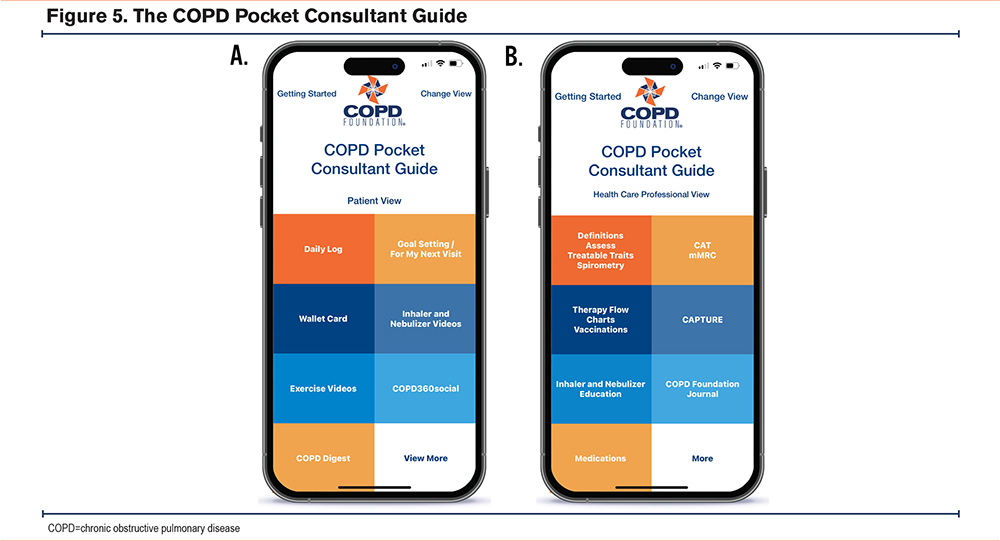
The Future of the COPD Foundation
The success of the first 20 years sets the COPDF on a trajectory for an amazing future. The COPDF initiated a strategic planning process in 2023 to plan the future of the Foundation with the primary goal of improving the lives of patients with COPD, bronchiectasis, and NTM lung disease. The 4 pillars of this plan (Figure 6) are below.

Go for the Cure
Finding a cure for COPD, bronchiectasis, and NTM lung disease remains an important goal of the patient community and the COPDF. This will require the ability to define and detect COPD at earlier stages and will need patient-inspired and FDA-recognized outcomes to move the needle and “find the statin for COPD.”
Make Life Better
Supporting patients and caregivers on their journey is integral to the COPDF. Continuing to build the online platform and ultimately integrating digital management tools is critical to this ongoing support. The launch of the Care Center Network for Bronchiectasis and NTM Lung Disease is an opportunity to enhance care in that patient community and may serve as a model for optimal COPD care.
Create a Movement
The COPDF continues to build a movement of awareness for COPD by being a primary source of information and research on COPD, bronchiectasis, and NTM lung disease, expanding existing campaigns (Harmonicas for Health,48 Lace up for Lungs,49 World Oxygen Day,50 World Bronchiectasis Day),51 and expanding partnerships with key governmental agencies (the FDA, NHLBI, and CDC) health care systems, institutions, and providers.
Raise the Money
Achieving these goals requires stable funding from a variety of sources, including the community, government, and corporate sponsors.
In Conclusion
The future is bright. New classes of medications are being introduced for the first time in decades. Social media and other forms of connection ensure that no patient or family has to make this journey alone. There is a story to tell, and a compelling need to meet. The COPDF is incredibly grateful to its supporters, collaborators, health care provider partners and most of all the patient community. To quote John W. Walsh, COPDF Founder, in the fitting phrase he ended every communication with, “keep the faith.”
Acknowledgements
We would like to acknowledge our incredible patient community who are the reason we exist. We ask you to think of the patients who have moved on in their journey; they inspire us. We also want to take this moment to remember John W. Walsh, COPD Foundation founder, fierce advocate, and a self-proclaimed impatient patient. While we miss John’s larger than life presence and his infectious belly laugh, his vision and passion still guide the Foundation each and every day.
Declaration of Interests
AH is a consultant to Qiu-Zucco, GRI Bio, and the COPD Foundation. BEM is a consultant to the COPD Foundation, Samay Health, Johnson & Johnson, GlaxoSmithKline, and ENA Respiratory and holds stock in GSK and Johnson & Johnson. BT is a consultant to Reckitt health. CGC is the managing editor of Chronic Obstructive Pulmonary Diseases: Journal of the COPD Foundation but had no role in the review process for this manuscript. DMM is a consultant to AstraZeneca, GlaxoSmithKline, Regeneron, Genentech, Up-to-Date, and the COPD Foundation, and is a medical expert for the Schlesinger Law Firm. All other authors have no conflicts to disclose.